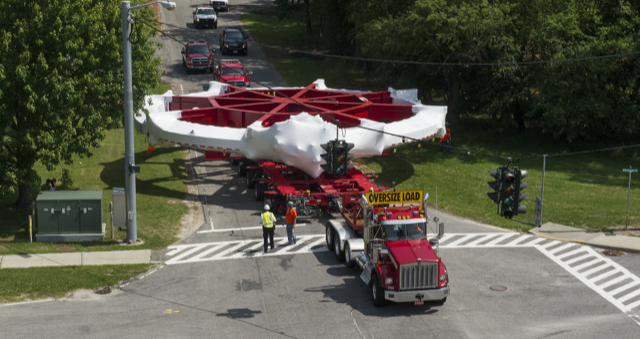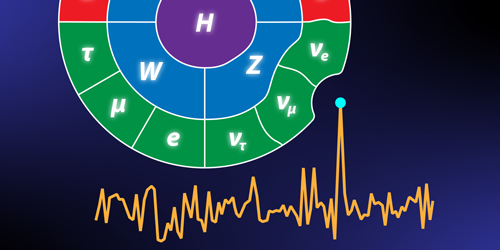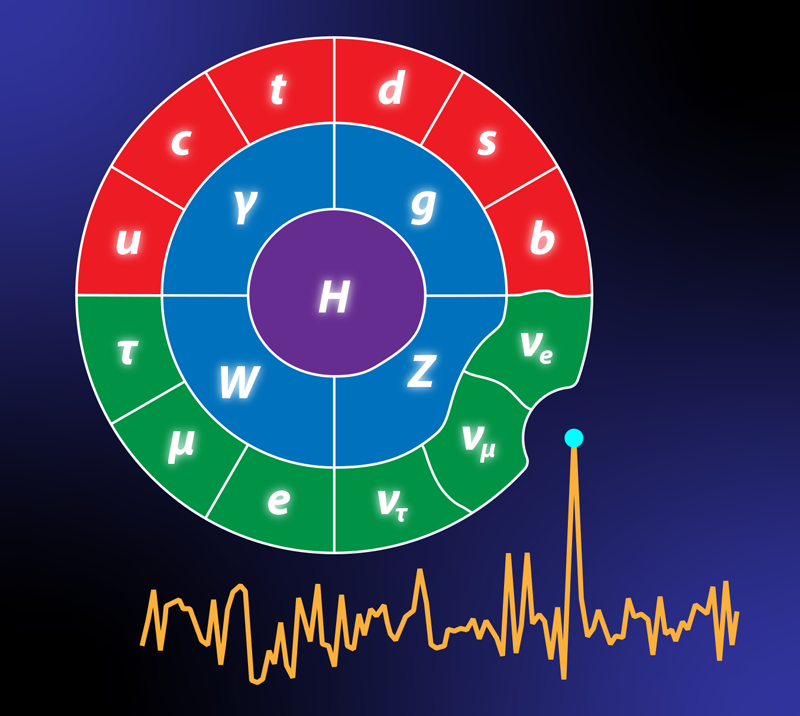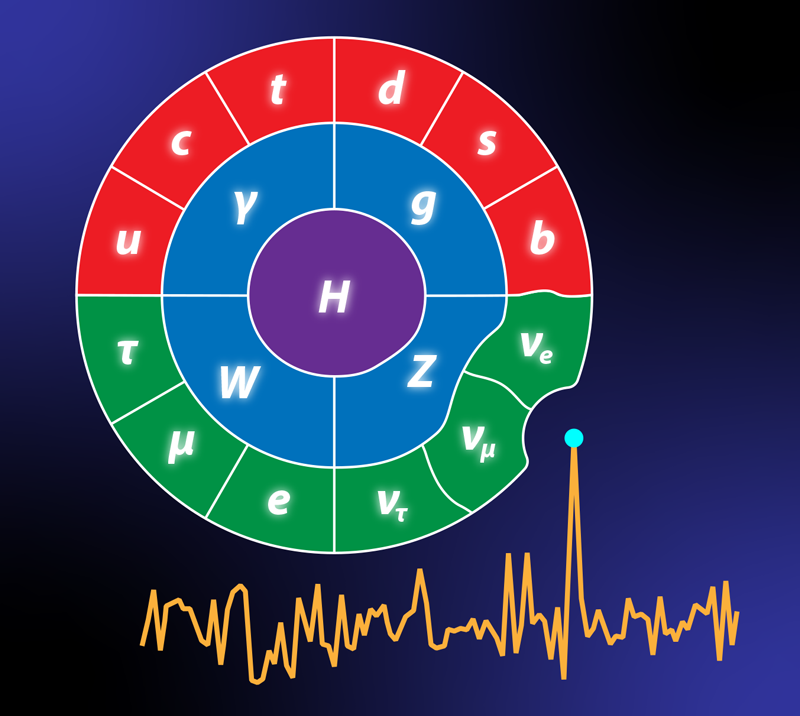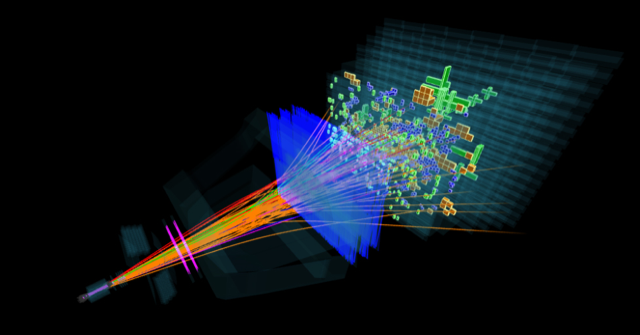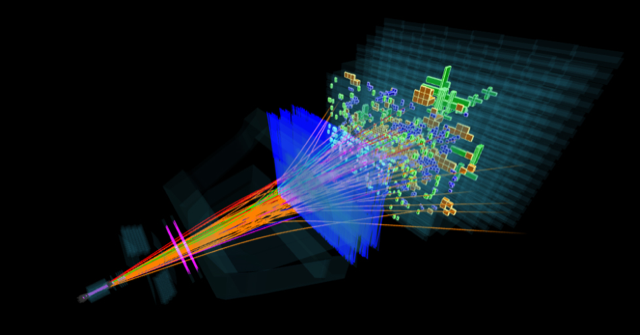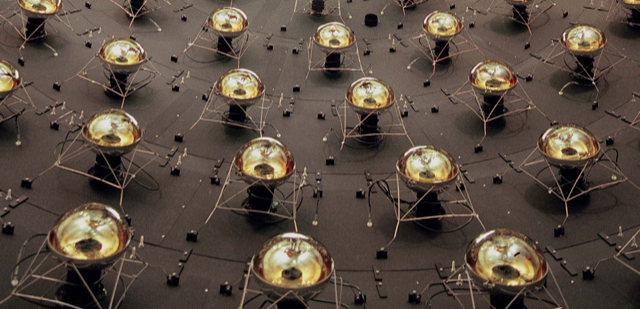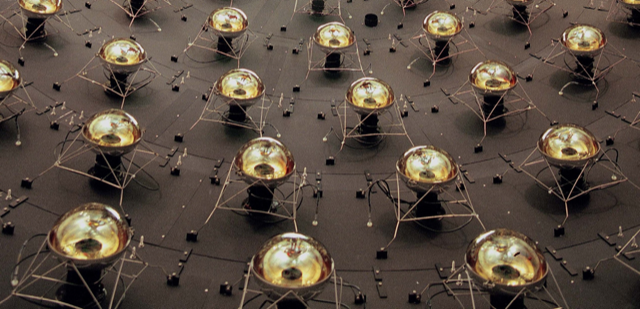The Era of Anomalies
To go beyond the realm of established theory, particle physicists are ready to move heaven and earth—and even giant magnets. In 2013, researchers packed up a circular magnet the width of a basketball court and sent it on a 3200-mile trip from New York to Illinois. Over the course of 35 days, the 15-ton magnet sailed down the East Coast, rounded the tip of Florida, floated up the Mississippi, and rode on the back of a truck to Fermilab, where it now serves as the central element of the revamped Muon g-2 experiment. Particle physicists went through this colossal effort to investigate a 3-parts-per-billion disagreement between theory and experiment over the value of the muon’s magnetic moment.
Although it may seem small, this discrepancy is one of the longest-standing anomalies in particle physics. Here, “anomaly” means a statistically significant experimental divergence from theoretical prediction. The theory in this case is the standard model of particle physics—a schema for all the known particles and forces besides gravity. The muon anomaly is not alone in contesting the standard model: other anomalies concern bottom quarks, neutrinos, and kaons. In recent years, these anomalies have taken on a new level of importance as possible routes to “new physics,” an umbrella term for phenomena unexplained by the standard model. There are more conspicuous paths to new physics, such as discovering a dark matter particle or unifying gravity with quantum physics. But these big problems have remained stubbornly out of reach, so many particle physicists are looking for inspiration from smaller problems.
“I think in many respects, anomalies are a good driver of scientific creativity,” says David Ireland, a nuclear physicist at the University of Glasgow in the UK. “It’s like a paradox; you have to resolve it.” Anomalies force experimentalists to find ways of reducing systematic uncertainties, analyzing their data, and conducting more precise searches. Theorists, meanwhile, must grapple with anomalous results by building models that often assume new particles, such as a cousin to the boson, a relative to the Higgs boson, or even a hybrid between the two types of matter particles (leptons and quarks).
So far, none of these proposed additions has been observed. But with more data coming in from experiments like Muon g-2 and Belle II, researchers are waiting to see if any anomalies become discoveries. “We think there should be more to life than just what the standard model can predict,” says Chris Polly, from Fermilab, who is the co-spokesperson of the Muon g-2 Collaboration.
Anomaly Disappearing Acts
When gambling, it’s wise to remember that the house always wins. The same could be said for betting on anomalies. Over the past few decades, just about every experimental result in conflict with the standard model’s predictions has disappeared over time, becoming less and less of a discrepancy as more data are taken. “What usually happens with an anomaly is that it goes away because it’s a statistical fluctuation, or it’s an experimental error,” says Jim Cline, a theoretical physicist at McGill University in Canada.
Anomalies are characterized by their sigma value, which is not a measure of how likely a result is real, but a measure of how likely it happens by chance. Suppose you see an unexpected peak in your data and wonder if it’s a new particle. To find the sigma value, you assume there is no particle and ask: How many times on average would the experiment need to be repeated before that peak showed up as a statistical fluctuation? Anomalies are discrepancies significant to 3 sigma, which corresponds to a fluke that would occur in one-in-740 runs of the experiment. Results below 3 sigma are frequently overturned. “I think one should always start skeptical,” says Gino Isidori, a theoretical physicist at the University of Zürich. Before treating a blip in the data as a possibility of something real, “one should first do a sanity check,” he says.
Most anomalies never make it to 5 sigma (equivalent to a one-in-3.5-million-chance fluke), which is required to claim a discovery. But even when they do, it’s still not time to break out the champagne. In 2011, the OPERA experiment infamously reported seeing neutrinos moving faster than the speed of light. Their observation was significant to more than 6 sigma but—perhaps unsurprisingly—turned out to be an experimental error.
A few years later, an excess of two-photon events at the Large Hadron Collider at CERN seemed to suggest the existence of a new particle with a mass of 750 GeV (see Synopis: Explaining a 750 GeV Bump). Theorists conjectured that such a particle could be evidence of supersymmetry, a mathematically elegant theory for new physics that many have long hoped to be true. The excitement led to over 500 papers being published on this anomaly. But eventually, it too disappeared. There was no experimental error, but the 3.5-sigma result faded as further data showed that it was no more than a statistical fluctuation.
Anomalies are as much the product of theoretical predictions as they are of experimental measurements. The experimental value for the muon’s magnetic moment has remained essentially unchanged since 2001, when it was last measured. But the anomaly has gotten stronger—now reaching 3.3 sigma—as theoretical calculations of the muon’s magnetic interactions have improved.
Not every discrepancy is seen as an anomaly. Last year, two groups made separate estimates of a parameter governing the decay of the lambda hyperon (a particle composed of an up, a down, and a strange quark). The first value is in slight tension with the second, but Ireland, a member of the second group, doesn’t consider it an anomaly indicative of new physics. He suspects that the tension will resolve itself once a careful comparison of analysis methods is done.
Theorists on Call
Anomalies may be regarded with skepticism, but they often open the door for theorists to play. One of the most promising sandboxes for model builders has been anomalies in physics—interactions involving mesons, which are particles composed of a bottom quark or antiquark plus another type of quark. A coterie of results from LHCb at CERN, Belle in Japan, and Babar in the US, point to potential problems with the standard model predictions for some rare meson decays.
Alone, each notable physics result is only a few-sigma discrepancy. But taken together, the aggregate of the results is—depending on whom you ask—a 5- to 7-sigma deviation from the standard model estimates. “I’ve worked in the field for a long time,” says Isidori. “We’ve seen a lot of anomalies here and there popping up and going back, but this time I think it’s different… . For the first time, it’s not just one thing that doesn’t fit with the other, but it’s a coherent set of things.”
If the anomalies are a hint of something real, the simplest explanation is a new particle called the , a partner to the boson that differs only slightly in its interactions with other particles (see Synopsis: Closing in on the Z' Boson). Isidori is not a big fan of the ; he prefers a leptoquark. This hypothetical particle would form a bridge between leptons (electrons, muons, and taus) and quarks (see Viewpoint: A Challenge to Lepton Universality).
Many theorists attempt to link anomalies together in models. For example, a new anomaly from KOTO, an experiment at JPARC in Japan, measuring the lifetime of neutral kaons, has piqued theorists’ attention. Jia Liu, a theoretical physicist at the University of Chicago, wrote a paper that proposed a light, Higgs-like particle, or scalar boson, that would interact with muons and would explain both the KOTO anomaly and the muon anomaly. While theorists like finding one explanation for multiple anomalies, it’s often difficult to match all the data. Attempts to find a combined explanation for both the physics and muon anomalies have mostly fallen flat. “Two anomalies to deal with is my limit, because it is not easy,” Liu says jokingly.
The best models, according to theorists, are those that fit the data naturally, without too much finagling. Neutrinos have been the focus of several recent anomalies, such as unexpected oscillations in the flavors of neutrinos observed by MiniBooNE at Fermilab in 2018 (see Viewpoint: The Plot Thickens for a Fourth Neutrino). To explain neutrino anomalies, “the most straightforward thing to do is to introduce one new neutrino” says Mona Dentler, a neutrino physicist at the University of Göttingen, Germany. The trouble is that this addition, called a sterile neutrino, is a possible dark matter candidate, which means it must agree with cosmological data. Constraints like this can require highly tailored solutions from theorists. “You normally have to kind of stand on your head and add a bunch of different epicycles to somehow make the data fit your models,” says Patrick Meade, a theorist at Stony Brook University, New York.
New from the Odd
There is no easy way to clarify the status or confidence physicists have in anomalies. The KOTO result, for example, is a new anomaly, which leads many to be more skeptical of it. Depending on whom you ask, the ten-year-old mystery of the proton radius is or isn’t resolved by the latest data from Jefferson Lab in the US and from York University in Canada. And anomalies are often shifting. While this article was being researched, a 3-sigma B physics anomaly may have disappeared, but a 2.2-sigma anomaly related to the Higgs popped up.
Since the Higgs was discovered in 2012, anomalies have gained currency as some of the only breadcrumbs available for particle physicists to follow on the path toward new physics. “I think the fraction of people working on or interested in anomalies increased after the Higgs [discovery],” says Isidori.
Meade doesn’t believe that the post-Higgs era is completely dominated by anomaly hunting, but he admits it has changed the way he works. “In the early 2000s, everybody was trying to solve a bigger problem,” he says. “What is naturalness? Can I come up with a model for the origin of flavor? Can I solve quantum gravity?” In recent work, Meade has focused on more targeted solutions, like a new Higgs-interacting particle that could explain the KOTO anomaly.
Coming up with models that explain minute discrepancies in the data may lack some of the grandeur of trying to solve quantum gravity. But for the time being, anomalies offer fresh challenges to the standard model. So particle physicists will continue hunting down blips in the data and proposing new models to explain the discrepancies, even though the future is uncertain.
“These models may be killed by these anomalies going away, or they may be textbook material for future decades,” says Patrick Koppenburg from the Dutch National Institute for Subatomic Physics (Nikhef). “We don't know.”
–Dan Garisto
Dan Garisto is a freelance science journalist based in Long Island, New York. He has written about physics for publications such as Scientific American, Symmetry, and IEEE Spectrum.



